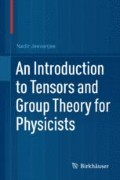Abstract
Chapter 5 discusses representation theory, which formalizes the notion of an object that transforms in a certain way under a given transformation (e.g. vectors under rotations, or antisymmetric tensors under boosts). We begin by defining a representation of a group as a vector space on which that group acts, and we give many examples, using the vector spaces we met in Chap. 2 and the groups we met in Chap. 4. We then discuss how to take tensor products of representations, and we see how this reproduces the additivity of quantum numbers in Quantum Mechanics. We then define irreducible representations, which are in a sense the ‘smallest’ ones we can work with, and we compute these representations for SU(2). These just end up being the familiar spin j representations, where j is a half-integer. We then use these results to compute the irreducible representations of the Lorentz group as well.
Access this chapter
Tax calculation will be finalised at checkout
Purchases are for personal use only
Notes
- 1.
There is, of course, such a thing as a right-handed spinor as well, which we will meet in the next section and which is also used to describe massless spin 1/2 particles. The right and left-handed spinors are known collectively as Weyl spinors, in contrast to the Dirac spinors, which are used to describe massive spin 1/2 particles. We shall discuss Dirac spinors towards the end of this chapter.
- 2.
You shouldn’t be surprised at the nomenclature here, since we saw in Example 3.29 that pseudovectors are essentially 3×3 antisymmetric matrices, which are exactly \(\mathfrak{so}(3)\)!
- 3.
Namely, that the vector space in question, \(\mathfrak{sl}(2,\mathbb{C})_{\mathbb{R}}\), is usually regarded as a three-dimensional complex vector space in the literature, not as a six-dimensional real vector space (which is the viewpoint of interest for us), so to avoid confusion we omit this topic. This will not affect any discussions of physical applications.
- 4.
And, as we will see, between the vector and pseudovector representations of O(3,1).
- 5.
We should mention here that the infinite-dimensionality of L 2(ℝ3) makes a proper treatment of the induced Lie algebra representation quite subtle; for instance, we calculate in this example that the elements of \(\mathfrak{so}(3)\) are to be represented by differential operators, yet not all functions in L 2(ℝ3) are differentiable! (Just think of a step function which is equal to 1 inside the unit sphere and 0 outside the unit sphere; this function is not differentiable at r=1.) In this example and elsewhere, we ignore such subtleties.
- 6.
Just as in the previous example, however, one can define transformed coordinates θ′ and φ′ and then unitarity hinges on the Jacobian determinant \(\vert \frac{\partial(\theta,\phi )}{\partial(\theta',\phi')}\vert \) being equal to one, which it is because rotations preserve area on the sphere.
- 7.
Each \(Y\in\tilde{\mathcal{H}}_{l}\) is the restriction of a polynomial to S 2 and is hence continuous, hence |Y|2 must have a finite maximum M∈ℝ. This implies
 (5.20)
(5.20) - 8.
See Goldstein [6].
- 9.
We will not prove this here; see Hall [8] for details.
- 10.
Note that an irreducible representation is, trivially, completely reducible, since V=V is a decomposition into irreducibles. Thus ‘irreducible’ and ‘completely reducible’ are not mutually exclusive categories, even if they may sound like it!
- 11.
This terminology is not standard but will prove useful.
- 12.
- 13.
In some texts our first notion of direct sum, in which we decompose a vector space into mutually exclusive subspaces, is called an internal direct sum, and our second notion of direct sum, in which we take distinct vector spaces and add them together, is known as an external direct sum.
- 14.
You may object to the use of i in our definition of these operators; after all, \(\mathfrak{su}(2)\) is a real Lie algebra, and so the expression S 2+iS 1 has no meaning as an element of \(\mathfrak{su}(2)\), and so one cannot say that, for instance, Y l =π(S 2+iS 1). Thus X l and Y l are not in the image of \(\mathfrak{su}(2)\) under π l . This is a valid objection, and to deal with it one must introduce the notion of the complexification of a Lie algebra. A discussion of this here would lead us too far astray from our main goals of applications in physics, however, so we relegate this material to the appendices which you can consult at leisure.
- 15.
See Herstein [9], for instance.
- 16.
For the whole story on this relationship, see Onischik [11].
- 17.
This should seem plausible, but proving it rigorously would require homotopy theory and would take us too far afield. See Frankel [4] for a nice discussion of this topic.
- 18.
See Sternberg [16].
References
T. Frankel, The Geometry of Physics, 1st ed., Cambridge University Press, Cambridge, 1997
H. Goldstein, Classical Mechanics, 2nd ed., Addison-Wesley, Reading, 1980
M. Göckeler and T. Schücker, Differential Geometry, Gauge Theories, and Gravity, Cambridge Monographs on Mathematical Physics, Cambridge University Press, Cambridge, 1987
B. Hall, Lie Groups, Lie Algebras and Representations: An Elementary Introduction, Springer, Berlin, 2003
I. Herstein, Topics in Algebra, 2nd ed., Wiley, New York, 1975
A.L. Onishchik, Lectures on Real Semisimple Lie Algebras and Their Representations, ESI Lectures in Mathematics and Physics, 2004
J.J. Sakurai, Modern Quantum Mechanics, 2nd ed., Addison-Wesley, Reading, 1994
S. Sternberg, Group Theory and Physics, Princeton University Press, Princeton, 1994
V.S. Varadarajan, Lie Groups, Lie Algebras and Their Representations, Springer, Berlin, 1984
Author information
Authors and Affiliations
Corresponding author
Rights and permissions
Copyright information
© 2011 Springer Science+Business Media, LLC
About this chapter
Cite this chapter
Jeevanjee, N. (2011). Basic Representation Theory. In: An Introduction to Tensors and Group Theory for Physicists. Birkhäuser Boston. https://doi.org/10.1007/978-0-8176-4715-5_5
Download citation
DOI: https://doi.org/10.1007/978-0-8176-4715-5_5
Publisher Name: Birkhäuser Boston
Print ISBN: 978-0-8176-4714-8
Online ISBN: 978-0-8176-4715-5
eBook Packages: Mathematics and StatisticsMathematics and Statistics (R0)


